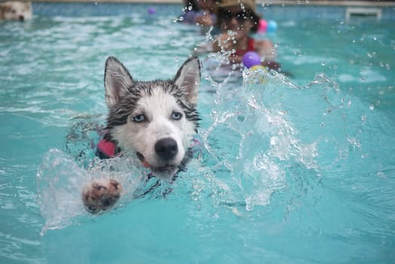 It's summertime! Although if you live on the west coast or in a place with hot temps, it's "summer-like" for the most of the year. But around this time is when you will start to see more posts about leaving your dog in the car, dangers of heatstroke and walking on pavement. (I'd like to add a 4th message about taking your dog to the beach - STAY TUNED!) Let's first talk about ground temperatures, though, when you take your dog outside for a walk. It doesn't necessarily have to be pavement either as dirt and sand can cause burns and problems. In general, if it's not something that you would walk on barefoot, your dog shouldn't either. If you're not barefoot, feel the surface with the back of your hand for 5-10 seconds. It's a misnomer to think that your pet's paw pads are durable or tough enough to withstand increased temps. Speaking of paws, there are a limited number of sweat glands there and your dog mainly dispels heat through panting. This could be a challenge if it's a hotter day and your dog is not conditioned to going out for a big walk or run - think "Weekend Warrior Syndrome" because it exists with pets as well. Somebody recently posted on Facebook about heatstroke happening during a walk over Memorial Day weekend. Bystanders saw what was happening by a park and happened to have some ice to help cool the dog down. But it took awhile. She ended up going to the vet for IV dehydration. This can happen in minutes with dogs and it happens in dogs of all sizes and breeds. Brachiocephalic dogs with compromised breathing (i.e., bulldogs, pugs) are even more at risk. Two things:
0 Comments
 Canine anatomy, particularly the musculoskeletal system, is remarkably similar to human anatomy. The major difference (besides fur!) is the fact that we walk upright on two legs and they walk on all fours (quadruped). “Joints” are intersections between one or more bones. The major joints of the canine skeletal system that you should be aware of in terms of location and “name” are: glenohumeral (shoulder), iliofemoral (hip), stifle (knee), and hock (ankle). CONSIDERATION AND FUN FACT: If a ligament (primarily collagen, non-contractile tissue) tears, it does not repair (or reattach) itself! The dog may appear to be “healed” because the inflammation may subside, and / or they have reduced pain over time, but do not mistake this for regeneration of collagen fibers. The more contractile fibers in a tissue the better. Muscles are primarily contractile tissues and little, if any, collagen. Collagen doesn’t contract and therefore isn’t considered an “active” body tissue in that sense. It is abundantly found in ligaments and tendons. FUN FACT: In general, dogs have more skeletal muscle than people. --- Excerpt: "OPTIMIZING FITNESS FOR PERFORMANCE IN DOGS" book. (See my store for details) - ON SALE! |
Proudly powered by Weebly


 RSS Feed
RSS Feed